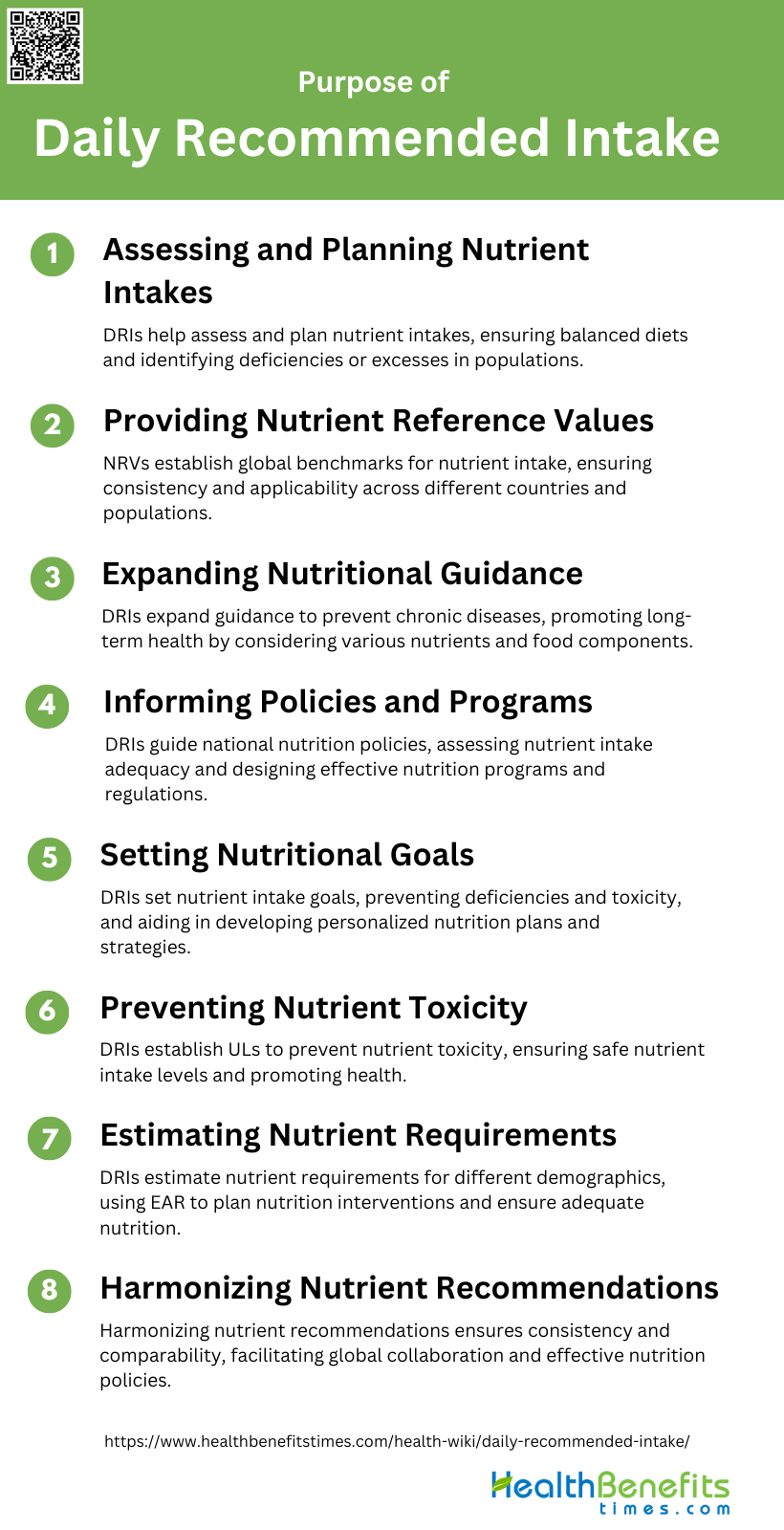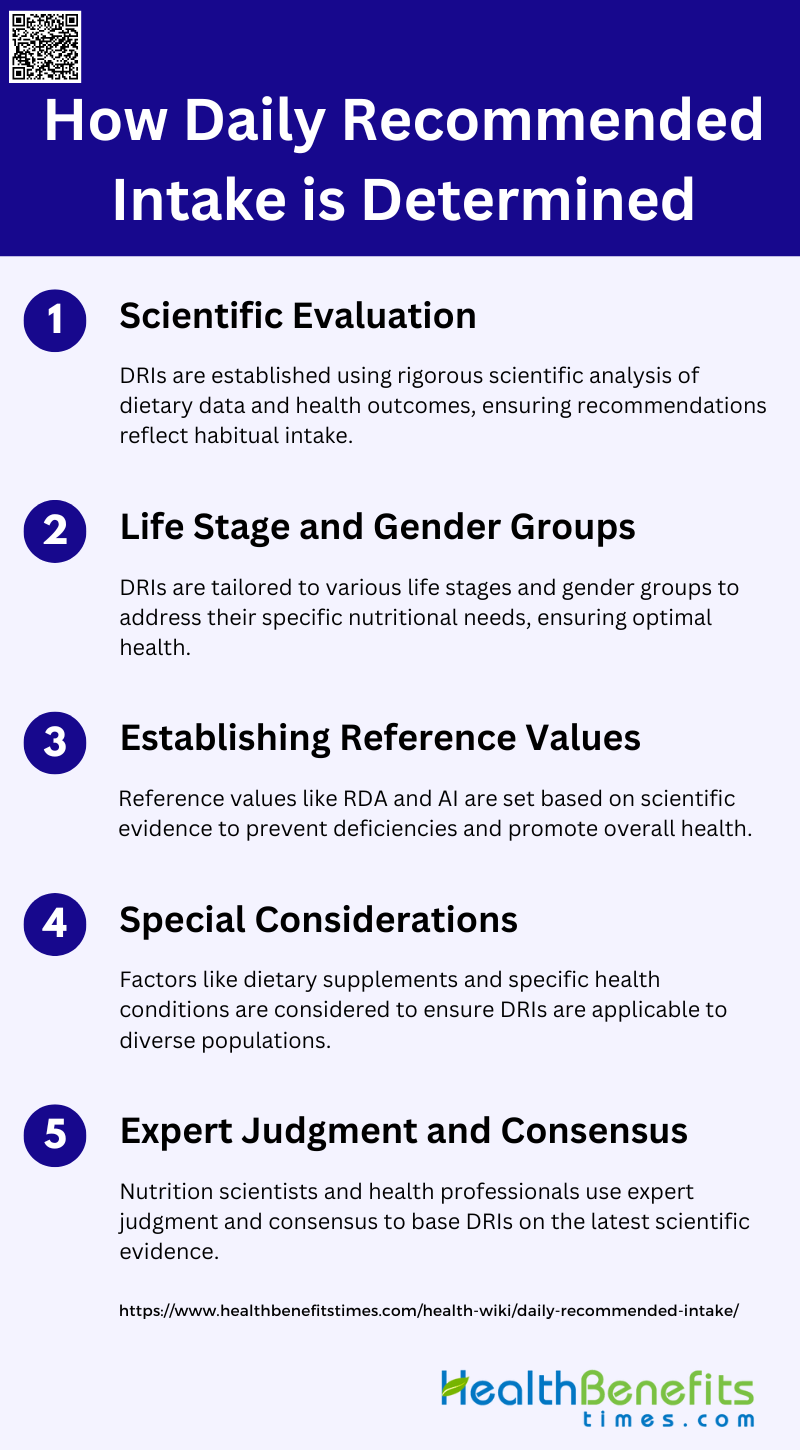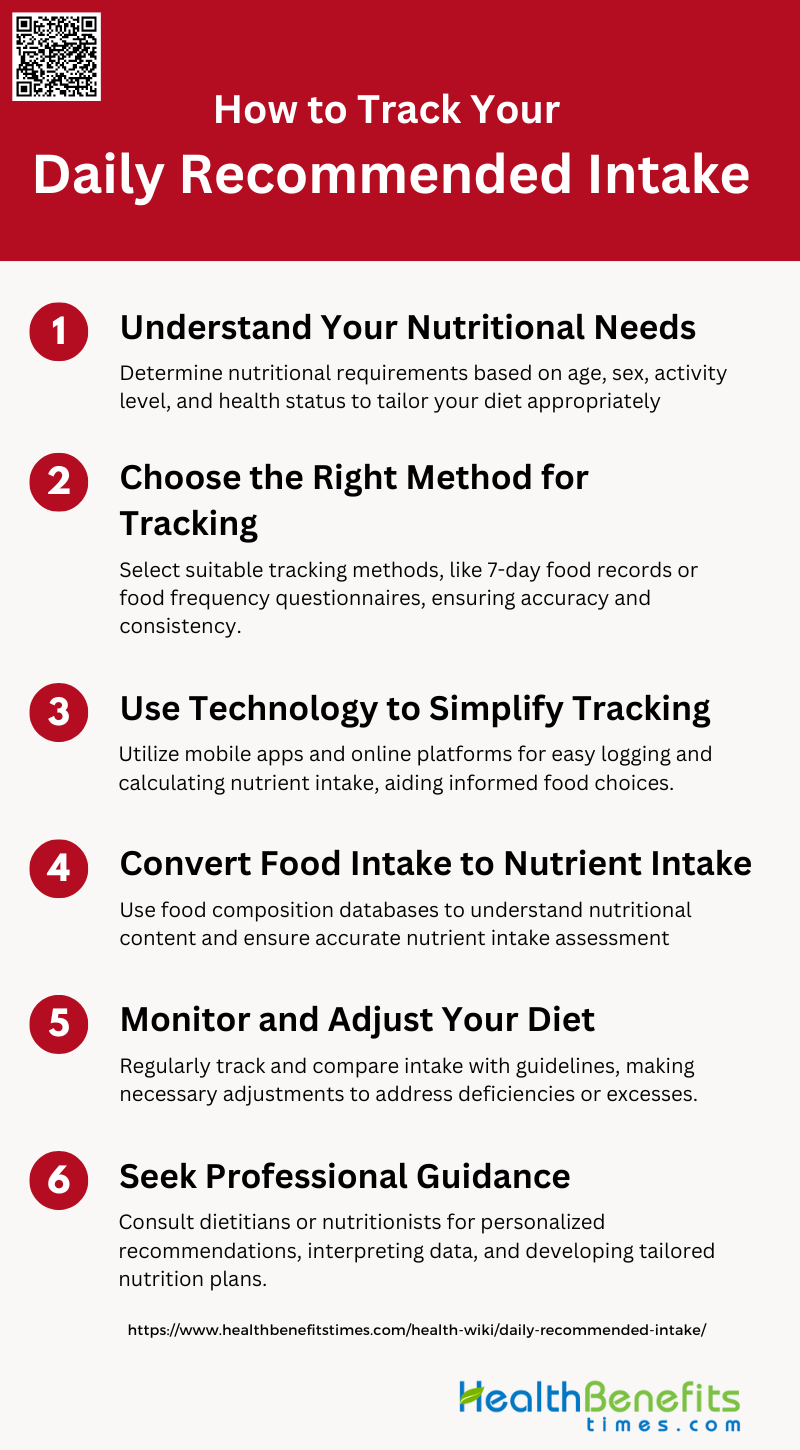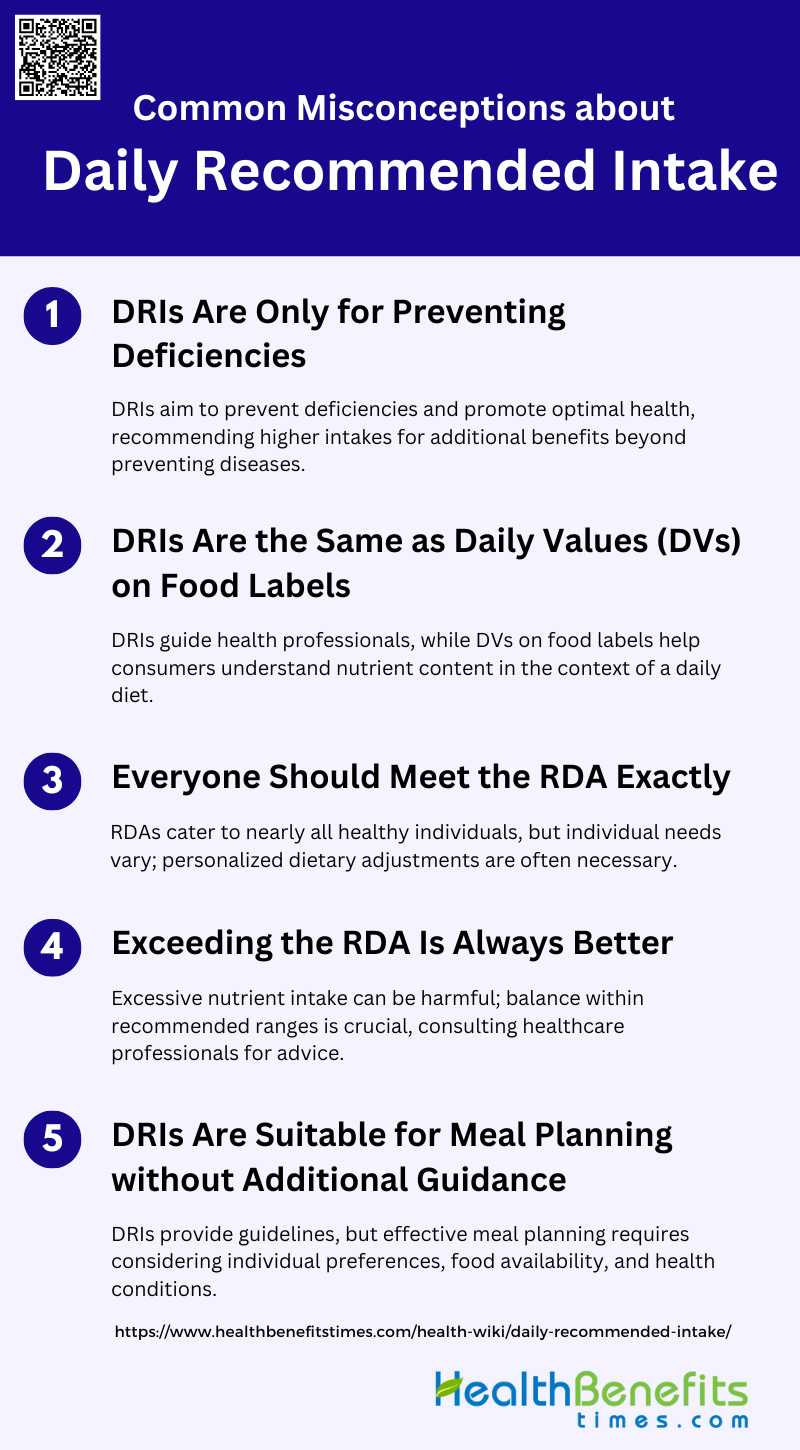The Daily Recommended Intake (DRI) is a set of reference values used to plan and assess the nutrient intakes of healthy individuals. Established by the Institute of Medicine (now the National Academy of Medicine), DRIs encompass several types of nutrient intake recommendations, including the Recommended Dietary Allowance (RDA), Adequate Intake (AI), Tolerable Upper Intake Level (UL), and Estimated Average Requirement (EAR). These values are designed to cover the needs of nearly all healthy individuals in a specific age and gender group, helping to prevent nutrient deficiencies and reduce the risk of chronic diseases. The DRIs are widely used in the United States and Canada for dietary planning and policy-making, ensuring that the population meets its nutritional needs through balanced diets.
Components of Daily Recommended Intake
Understanding the components of daily recommended intake is crucial for maintaining a balanced diet and ensuring optimal health. These components include essential nutrients that our bodies need to function properly. Below is a list of the key components that should be included in your daily intake to support overall well-being.
1. Recommended Dietary Allowance (RDA)
The Recommended Dietary Allowance (RDA) is defined as the average daily dietary intake level sufficient to meet the nutrient requirements of nearly all (97-98%) healthy individuals in a particular life stage and gender group. The purpose of the RDA is to serve as a goal for daily intake by individuals to ensure adequate nutrition and prevent deficiencies. The RDA is determined using a coefficient of variation, typically 10-15%, to account for individual variability in nutrient needs, and is based on the Estimated Average Requirement (EAR) plus an additional margin to cover the needs of almost all individuals.
2. Adequate Intake (AI)
Adequate Intake (AI) is defined as a recommended average daily nutrient intake level based on observed or experimentally determined approximations of nutrient intake by a group of healthy people. The purpose of AI is to provide a target intake level when an RDA cannot be determined due to insufficient evidence. AI is determined by observing the average intake levels of a healthy population and using this data to estimate a level that appears to sustain nutritional adequacy.
3. Tolerable Upper Intake Level (UL)
The Tolerable Upper Intake Level (UL) is defined as the highest average daily nutrient intake level that is likely to pose no risk of adverse health effects for almost all individuals in the general population. The purpose of the UL is to help prevent nutrient toxicity by providing a maximum intake level that should not be exceeded. The UL is determined by evaluating the risk of adverse effects from excessive nutrient intake and incorporating a coefficient of variation, typically around 45%, to account for individual differences in sensitivity to nutrient toxicity.
4. Estimated Average Requirement (EAR)
The Estimated Average Requirement (EAR) is defined as the daily nutrient intake value that is estimated to meet the requirement of half the healthy individuals in a particular life stage and gender group. The purpose of the EAR is to serve as a basis for setting the RDA and to assess the nutrient intakes of populations. The EAR is determined by reviewing available scientific evidence on nutrient requirements and calculating the median intake level that meets the needs of 50% of the population.
Purpose of Daily Recommended Intake
The purpose of daily recommended intake is to ensure that individuals receive the necessary nutrients to maintain optimal health. These guidelines help prevent nutrient deficiencies and promote overall well-being. Below is a list of the key purposes of following daily recommended intake guidelines.
1. Assessing and Planning Nutrient Intakes
Daily Recommended Intake (DRI) values are essential for assessing and planning nutrient intakes to ensure that populations meet their nutritional needs. DRIs provide a comprehensive framework that includes the Recommended Dietary Allowance (RDA), Estimated Average Requirement (EAR), Adequate Intake (AI), and Tolerable Upper Intake Level (UL). These values help in evaluating the adequacy of nutrient intakes and identifying potential deficiencies or excesses in different population groups. By using DRIs, nutritionists and health professionals can design balanced diets and meal plans that meet the specific nutritional requirements of individuals and groups, thereby promoting overall health and well-being.
2. Providing Nutrient Reference Values
Nutrient Reference Values (NRVs) are critical for establishing benchmarks for nutrient intake that can be used globally. The harmonization of NRVs, such as the Average Requirement (AR) and Tolerable Upper Intake Level (UL), ensures that these values are consistent and applicable across different countries and populations. This harmonization process involves adopting systematic reviews, bias assessment methodologies, and updated food and nutrient databases to derive accurate and comparable estimates of nutrient intakes. By providing standardized NRVs, health organizations can offer reliable guidance on nutrient intake, which is essential for developing nutrition policies and programs.
3. Expanding Nutritional Guidance
DRIs play a pivotal role in expanding nutritional guidance beyond the prevention of deficiency diseases to include the promotion of long-term health. The comprehensive approach of DRIs encompasses various nutrients and food components, considering their roles in preventing chronic diseases and supporting overall health. This expanded guidance helps in formulating dietary recommendations that address a wide range of health outcomes, including the prevention of chronic diseases such as cardiovascular disease, diabetes, and cancer. By incorporating the latest scientific evidence, DRIs provide a robust foundation for developing dietary guidelines that promote optimal health and well-being.
4. Informing Policies and Programs
DRIs serve as a foundational tool for informing national nutrition and public health policies. They provide evidence-based reference values that guide the development of nutrition monitoring and intervention programs, food labeling regulations, and dietary guidelines. These reference values are used to assess the adequacy of nutrient intakes in populations and to design policies that address nutritional deficiencies and promote public health. By providing a scientific basis for policy decisions, DRIs help ensure that nutrition programs are effective in improving the nutritional status and health outcomes of populations.
5. Setting Nutritional Goals
DRIs are instrumental in setting nutritional goals for individuals and populations. The RDA, which is designed to meet the nutrient needs of 97-98% of healthy individuals, serves as a target for nutrient intake. By setting these goals, DRIs help individuals achieve optimal nutrient intake levels that support health and prevent deficiencies. Additionally, DRIs provide guidance on the upper limits of nutrient intake to prevent toxicity and adverse health effects. These goals are essential for developing personalized nutrition plans and public health strategies that promote balanced and adequate nutrient intake.
6. Preventing Nutrient Toxicity
One of the key purposes of DRIs is to prevent nutrient toxicity by establishing Tolerable Upper Intake Levels (ULs). ULs represent the maximum daily intake of a nutrient that is unlikely to cause adverse health effects in the general population. By providing these upper limits, DRIs help health professionals and policymakers identify safe levels of nutrient intake and prevent the risks associated with excessive consumption. This is particularly important for nutrients that can be toxic at high levels, such as vitamin A and selenium, ensuring that dietary recommendations promote safety and health.
7. Estimating Nutrient Requirements
DRIs provide a scientific basis for estimating nutrient requirements for different population groups. The Estimated Average Requirement (EAR) is used to determine the nutrient intake level that meets the needs of 50% of individuals in a specific age and gender group. This value is essential for assessing the nutrient adequacy of populations and for planning nutrition interventions that address the specific needs of different demographic groups. By using EARs, health professionals can develop targeted strategies to ensure that all individuals receive adequate nutrition to support their health and well-being.
8. Harmonizing Nutrient Recommendations
Harmonizing nutrient recommendations across different countries and organizations is crucial for ensuring consistency and comparability in nutritional guidance. The process of harmonization involves adopting a unified approach to deriving NRVs, such as the AR and UL, and addressing barriers such as limited access to resources and variance in terminology. By harmonizing these recommendations, global health organizations can provide coherent and standardized guidance on nutrient intake, facilitating international collaboration and improving the effectiveness of nutrition policies and programs. This approach ensures that all populations have access to reliable and consistent nutritional information.
How Daily Recommended Intake is Determined
Determining the daily recommended intake (DRI) involves a comprehensive analysis of nutritional needs based on various factors. These factors include age, gender, weight, and activity level, among others. The following points outline the key steps and considerations in establishing DRI values:
1. Scientific Evaluation
The determination of daily recommended intake (DRI) involves rigorous scientific evaluation of dietary data and health outcomes. For instance, the National Health and Nutrition Examination Survey (NHANES) data is often used to estimate usual intake and assess the population’s nutrient adequacy. Analytical techniques, such as the National Cancer Institute (NCI) method, help estimate usual intake from limited dietary recall data, ensuring that recommendations are based on habitual intake rather than single-day consumption. This scientific approach ensures that DRIs are grounded in robust data, reflecting the dietary patterns and health needs of the population.
2. Life Stage and Gender Groups
DRIs are tailored to different life stages and gender groups to address varying nutritional needs. For example, the recommended intake of folic acid for women of childbearing age is set to prevent neural tube defects, with specific guidelines for different ethnic groups. Similarly, vitamin B-12 intake recommendations are adjusted for postmenopausal women to ensure adequate levels of this nutrient, which is crucial for preventing deficiency-related conditions. These tailored recommendations ensure that each demographic group receives appropriate guidance to maintain optimal health.
3. Establishing Reference Values
Establishing reference values for nutrient intake involves setting benchmarks like the Recommended Dietary Allowance (RDA) and Adequate Intake (AI). These values are derived from scientific evidence on the amounts needed to prevent deficiencies and promote health. For instance, the RDA for vitamin C is set to prevent scurvy, but higher intakes are suggested for optimal health benefits. Similarly, modeling studies show that meeting dairy intake recommendations can significantly improve nutrient adequacy for vitamins and minerals. These reference values provide a framework for dietary guidelines and public health policies.
4. Special Considerations
Special considerations are taken into account when setting DRIs, such as the impact of supplements and specific health conditions. For example, the use of dietary supplements significantly influences nutrient intake and can help individuals meet their nutritional needs. Additionally, certain health conditions, like diabetes, can affect nutrient requirements and intake patterns, necessitating tailored recommendations. These considerations ensure that DRIs are comprehensive and applicable to diverse populations with varying health statuses and dietary habits.
5. Expert Judgment and Consensus
The process of determining DRIs involves expert judgment and consensus from nutrition scientists and health professionals. This collaborative approach ensures that recommendations are based on the latest scientific evidence and reflect a broad range of expertise. For instance, the guidelines for carbohydrate intake for athletes are based on extensive research and expert consensus on the benefits of high carbohydrate availability for endurance and performance. This expert-driven process ensures that DRIs are credible, scientifically sound, and widely accepted within the health and nutrition community.
Benefits of Following Daily Recommended Intake
Following the daily recommended intake (DRI) offers numerous health benefits, ensuring that your body receives essential nutrients in the right amounts. Adhering to these guidelines can improve overall well-being, boost energy levels, and reduce the risk of chronic diseases. Here are some key benefits of following the DRI:
1. Ensuring Nutritional Adequacy
Following the daily recommended intake of various food groups ensures that individuals receive essential nutrients necessary for maintaining health. For instance, increasing dairy consumption to the recommended levels significantly improves the intake of calcium, magnesium, and vitamin A, which are often under-consumed. Similarly, meeting the recommended intake of fruits and vegetables provides essential vitamins, minerals, and dietary bioactives that contribute to overall nutritional adequacy. Whole grains also play a crucial role, as their consumption is associated with a reduced risk of type 2 diabetes, highlighting the importance of adhering to dietary guidelines to meet nutritional needs.
2. Promoting Overall Health
Adhering to daily recommended intakes promotes overall health by reducing the risk of chronic diseases. Increased consumption of fruits and vegetables is linked to a lower risk of cardiovascular diseases and certain cancers. Additionally, incorporating healthy dietary changes, such as increasing fruit and vegetable intake, has been shown to improve cardiovascular disease risk factors, including blood pressure and cholesterol levels. Regular consumption of whole grains is also associated with a significant reduction in the risk of type 2 diabetes, further emphasizing the health benefits of following dietary recommendations.
3. Avoiding Nutrient Toxicity
Following daily recommended intakes helps avoid nutrient toxicity, which can occur when certain nutrients are consumed in excess. For example, while fruit juice can help meet fruit intake recommendations, it is important to balance its consumption due to its high sugar content, which can lead to adverse health effects if consumed in large quantities. Similarly, adhering to recommended dairy intake ensures that individuals do not consume excessive amounts of certain nutrients, such as calcium, which can lead to health issues like kidney stones. Thus, following dietary guidelines helps maintain nutrient balance and prevent toxicity.
4. Supporting Dietary Planning and Assessment
Daily recommended intakes serve as a valuable tool for dietary planning and assessment, helping individuals and healthcare professionals design balanced diets. By following these guidelines, individuals can ensure they are consuming a variety of foods that provide essential nutrients. For instance, modeling studies have shown that increasing dairy consumption to recommended levels can significantly improve nutrient intakes and reduce the prevalence of inadequate micronutrient intakes. Similarly, public health policies that promote increased fruit and vegetable intake can help individuals achieve a balanced diet and improve overall health outcomes.
5. Informing Public Health Policies and Programs
Daily recommended intakes are crucial for informing public health policies and programs aimed at improving population health. Evidence-based dietary guidelines help shape interventions and campaigns that encourage healthy eating habits. For example, public health policies that promote the consumption of fruits and vegetables can lead to significant reductions in the incidence of chronic diseases, such as cardiovascular diseases and certain cancers. Additionally, recommendations for whole grain intake can help reduce the risk of type 2 diabetes, further supporting the development of effective public health strategies.
6. Enhancing Research and Education
Adhering to daily recommended intakes enhances research and education by providing a framework for studying the health impacts of various dietary patterns. Research studies often use these guidelines to assess the effects of different food groups on health outcomes. For instance, systematic reviews and meta-analyses have demonstrated the benefits of increased fruit and vegetable intake on cardiovascular health and the prevention of chronic diseases. Educational programs that promote understanding and adherence to dietary guidelines can empower individuals to make informed food choices, ultimately leading to better health outcomes.
How to Track Your Daily Recommended Intake
Tracking your daily recommended intake (DRI) is crucial for maintaining a balanced diet and achieving your health goals. By monitoring your nutrient consumption, you can ensure you’re meeting your body’s needs and making informed dietary choices. Here are some effective methods to track your DRI:
1. Understand Your Nutritional Needs
Understanding your nutritional needs is the first step in tracking your daily recommended intake. Nutritional requirements vary based on factors such as age, sex, physical activity level, and health status. For instance, older adults need higher protein intake to maintain muscle mass and bone health, while athletes may require more carbohydrates and proteins to meet their energy expenditure and support recovery. The Nordic Nutrition Recommendations provide detailed guidelines on the proportions of energy-yielding nutrients and recommended daily intakes of vitamins and minerals for different age and sex groups. By understanding these needs, you can tailor your diet to meet your specific health and performance goals.
2. Choose the Right Method for Tracking
Selecting an appropriate method for tracking your food intake is crucial for accuracy and consistency. Methods such as 7-day food records, food frequency questionnaires, and commercially available food tracking programs like MyFitnessPal© are commonly used. Each method has its advantages; for example, 7-day food records provide a detailed quantification of food consumed, which is useful for short-term monitoring and guiding dietary changes. Food frequency questionnaires are beneficial for assessing habitual intake over longer periods. Choose a method that fits your lifestyle and provides reliable data to help you stay on track with your nutritional goals.
3. Use Technology to Simplify Tracking
Technology can significantly simplify the process of tracking your daily intake. Mobile apps and online platforms offer user-friendly interfaces for logging food consumption and calculating nutrient intake. For example, MyFitnessPal© allows users to input their meals and provides a breakdown of macronutrients and micronutrients. Additionally, food recommender systems that incorporate nutritional information and user preferences can help in planning balanced meals that meet daily requirements. Eye-tracking studies have shown that formats like the traffic light system are more efficient for consumers to process nutritional information, making it easier to make informed food choices.
4. Convert Food Intake to Nutrient Intake
Converting food intake to nutrient intake involves understanding the nutritional content of the foods you consume. This can be achieved by using food composition databases and tracking tools that provide detailed nutrient profiles. Studies have shown significant correlations between reported nutrient intake and biomarkers, confirming the reliability of food records in assessing dietary intake. For example, protein intake can be correlated with urinary urea excretion, and vitamin B12 intake with serum concentrations. By accurately converting your food intake to nutrient intake, you can ensure that you are meeting your dietary recommendations and making necessary adjustments.
5. Monitor and Adjust Your Diet
Regular monitoring and adjusting your diet are essential to ensure that you are meeting your nutritional needs. Studies have highlighted that many individuals, including athletes and older adults, often fall short of recommended intakes for key nutrients such as protein, vitamins, and minerals. By consistently tracking your intake and comparing it with dietary guidelines, you can identify deficiencies or excesses and make informed adjustments. For instance, increasing protein intake in older adults can help maintain muscle mass and functionality. Monitoring your diet allows you to stay proactive in managing your health and nutritional status.
6. Seek Professional Guidance
Seeking professional guidance from dietitians or nutritionists can provide personalized recommendations and support. Professionals can help interpret your dietary data, identify gaps, and develop tailored nutrition plans. Studies have shown that individuals often lack a basic understanding of their nutritional needs and can benefit from education and professional advice. For example, athletes who underestimate their carbohydrate and protein needs can improve their performance with proper guidance. Professional support ensures that you are making informed decisions and optimizing your diet for better health outcomes.
Common Misconceptions about Daily Recommended Intake
There are several common misconceptions about daily recommended intake (DRI) that can lead to confusion and poor dietary choices. Understanding these misconceptions is essential for making informed decisions about your nutrition. Here are some of the most prevalent myths about DRI:
1. DRIs Are Only for Preventing Deficiencies
A common misconception is that Dietary Reference Intakes (DRIs) are solely designed to prevent nutrient deficiencies. While DRIs do establish minimum levels to avoid deficiency diseases, such as scurvy in the case of vitamin C, they also aim to promote optimal health. For instance, the current Recommended Dietary Allowance (RDA) for vitamin C is set at 45 mg/day to prevent scurvy, but research suggests that higher intakes, ranging from 250 mg/day to 4000 mg/day, may offer additional health benefits, such as enhanced immune function and reduced incidence of chronic diseases.
2. DRIs Are the Same as Daily Values (DVs) on Food Labels
Another misconception is that DRIs are identical to Daily Values (DVs) found on food labels. While both are used to guide nutrient intake, they serve different purposes. DRIs are comprehensive guidelines used by health professionals to assess and plan dietary intake for individuals and populations. In contrast, DVs are simplified values used on food labels to help consumers understand the nutrient content of foods in the context of a total daily diet. The criteria and values for DVs are often derived from DRIs but are adjusted for labeling purposes and may not reflect the most current scientific recommendations.
3. Everyone Should Meet the RDA Exactly
It is a misconception that everyone should aim to meet the RDA exactly. The RDA is designed to meet the needs of nearly all (97-98%) healthy individuals in a specific age and gender group. However, individual nutrient needs can vary based on factors such as age, sex, health status, and lifestyle. For example, the ANIBES study found significant disparities between reported nutrient intakes and recommended levels, indicating that many individuals may require personalized dietary adjustments to meet their specific needs. Therefore, while the RDA serves as a useful benchmark, it is not a one-size-fits-all recommendation.
4. Exceeding the RDA Is Always Better
Exceeding the RDA is not always better and can sometimes be harmful. While higher intakes of certain nutrients, like vitamin C, may offer additional health benefits, excessive consumption can lead to adverse effects. For instance, very high intakes of vitamin C (above 2000 mg/day) can cause gastrointestinal disturbances and increase the risk of kidney stones. Therefore, it is important to balance nutrient intake within recommended ranges and consult healthcare professionals for personalized advice.
5. DRIs Are Suitable for Meal Planning Without Additional Guidance
Another misconception is that DRIs alone are sufficient for meal planning. While DRIs provide valuable guidelines, effective meal planning often requires additional considerations, such as individual dietary preferences, food availability, and specific health conditions. The ANIBES study highlighted that a significant portion of the population did not meet the recommended intakes for key nutrients like calcium, magnesium, and vitamin D, despite following general dietary guidelines. Therefore, personalized dietary advice from nutrition professionals is often necessary to ensure balanced and adequate nutrient intake.






